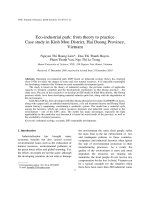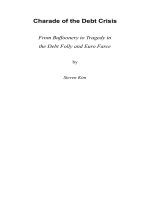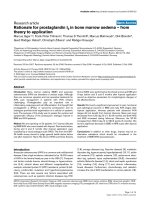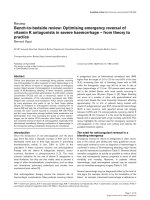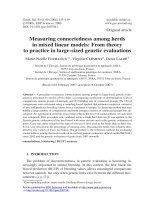Financial crisis from theory to experiences in east asia crisis (1997 1998) and the great recession (2007 2008)
Bạn đang xem bản rút gọn của tài liệu. Xem và tải ngay bản đầy đủ của tài liệu tại đây (522.54 KB, 31 trang )
FOREIGN TRADE UNIVERSITY
FACULTY OF BANKING AND FINANCE
--------------- ---------------
INTERNATIONAL FINANCE REPORT
FINANCIAL CRISIS: FROM THEORY TO
EXPERIENCES IN EAST ASIA CRISIS (1997 - 1998)
AND THE GREAT RECESSION (2007 - 2008)
Instructor: Assoc. Prof. Mai Thu Hien
Class:
Group:
Ha Noi, June 2023
TCHE414
FOREIGN TRADE UNIVERSITY
FACULTY OF BANKING AND FINANCE
--------------- ---------------
INTERNATIONAL FINANCE REPORT
FINANCIAL CRISIS: FROM THEORY TO
EXPERIENCES IN EAST ASIA CRISIS (1997 - 1998)
AND THE GREAT RECESSION (2007 - 2008)
GROUP:
– CLASS: TCHE414
Table of Contents
ABSTRACT.....................................................................................1
INTRODUCTION...........................................................................2
LITERATURE REVIEW..............................................................3
Chapter 1: Overview of Financial Crisis.....................................3
1.1. Definition............................................................................3
1.2. Causes of financial crises...................................................3
1.3. Types of financial crises.....................................................3
1.4. Explaining the consequences of financial crises...............4
Chapter 2: Financial Crisis Theories...........................................5
2.1. Minsky's Theory of Financial Crisis:.................................5
2.2. Marxist’s Theory of Financial Crisis.................................6
RESEARCH DIRECTION AND STRUCTURE........................7
METHODOLOGY..........................................................................8
DISCUSSION..................................................................................9
Chapter 3: Asian Financial Crisis (1997-1998)..........................9
3.1. Overviews and aspects of The Asian Financial Crisis......9
3.2. How do the governments and central banks respond?....13
Chapter 4: The Great Recession (2007-2009)...........................14
4.1. Overviews and aspects of The Great Recession..............14
4.2. Government Intervention in Response to The Great
Recession..................................................................................16
Chapter 5: Lessons for Crisis Prevention and Recommendation
for Crisis
.....................................................................................................
21
5.1. Lesson for Crisis Prevention............................................21
5.2. Recommendation for Crisis Resolution...........................21
LIMITATION AND CONCLUSION.........................................24
Limitation.....................................................................................24
Conclusion...................................................................................24
REFERENCE................................................................................26
ABSTRACT
Financial crises have historically had devastating effects on the economies
involved. Recognizing the significance of the financial crisis research, our paper
analyzes the financial crisis in the context of previous national experience and
economic theory and draws some valuable key takeaways. A variety of the crisis's
aspects, namely its concept, signs, types, causes and consequences, are discussed to
define what a financial concept is. With the usage of qualitative research methods and
theoretical analysis, our report has shed light on two notable financial crises: the 19971998 East Asian financial crisis and the financial crisis in 2008, as well as the policies
introduced by the government to tackle the crisis and the lessons noted to minimize
these mistakes. It should be noted that policies have been crucial in preventing the
crisis from evolving into a more complex one while not acting alone but in conjunction
with other measures to lessen the impact of the financial crises.
INTRODUCTION
Financial crisis is increasingly essential in countries going into a recession, and
failing to meet the demand for money. The economy, sociology, and politics of each
nation and each region have all been significantly impacted by it as it has sucked
numerous nations into its vortex. Unfortunately, the most severe financial crises are
currently affecting developing nations, including Haiti, South Africa, and Afghanistan,
all of which have long-standing financial problems. Developing countries are prone to
financial crises due to limited trade and fluctuations in income. Recent years have
witnessed more severe and complex financial crises, including the Mexico crisis in
1994, the Asian financial crisis in 1997, the Argentina crisis in 2001, and the Great
Depression of 2008-2009. These crises bring both challenges and opportunities for
those who are proactive.
During a financial crisis, asset prices plummet, individuals and businesses
struggle to repay debts, and financial institutions face liquidity shortages. This crisis is
often accompanied by panic or bank runs, where investors hastily sell assets or
withdraw funds from banks due to concerns about asset devaluation.
Financial crises can be caused by various factors such as unexpected human
behavior, systemic failures, risk-taking opportunities, regulatory deficiencies, or
contagious diseases
LITERATURE REVIEW
Chapter 1: Overview of Financial Crisis
1.1. Definition
A financial crisis or economic crisis is defined as a sudden loss in the value of
numerous monetary assets such as real estate and stocks, which may lead to an
economic collapse.
Following the 1929 Wall Street Crash, the globe experienced its largest
financial crisis. This crisis resulted in widespread bank collapse in the United States
and the interwar recession. The Great Crash (1929) by John Kenneth Galbraith stated
that the economy on the edge of the Great Depression was so unstable that it was only
waiting for something to trigger the catastrophe. It doesn't really matter what triggered
the occurrence; it could have been anything.
1.2. Causes of financial crises
It is difficult to summarize the entire literature on crisis causes or drivers, but
two large groups can be distinguished: studies linking financial crises to
macroeconomic instability (current account imbalances, public deficit growth, etc.),
and studies viewing financial nuisances as a feature of financial systems. However,
determining their underlying causes remains a challenge.
1.3. Types of financial crises
However, financial crises tend to have different forms, formats, and
characteristics, which means that studying the determinants of financial crises can be
biased when we rely only on a single definition of financial crisis. Reinhart and Rogoff
(2009b) describe two types of crises: those classified using strictly quantitative
definitions and those dependent largely on qualitative and judgmental analysis. The
first group mainly consists of currency and sudden stop crises, whereas the second
group contains debt and banking crises. Regardless, theories attempting to explain
crises have a major influence on definitions.
a. Currency crisis
A currency crisis, also known as an exchange rate crisis or a balance of
payments crisis, occurs when currency speculation causes a sharp devaluation of the
local currency or creates a situation in which foreign responsible authorities must
protect their currency by raising interest rates or spending large amounts of foreign
exchange reserves.
b. Sudden stop crisis
A sudden stop (or capital account or balance of payments crisis) is described as
a significant (and often unexpected) reduction in foreign capital inflows or a sharp
reversal in aggregate capital flows to a country, most likely occurring concurrently
with a sharp rise in its credit spreads. Because these are measurable variables, they
lend themselves to the use of quantitative methodologies.
c. Debt crisis
A debt crisis occurs when a country is unable to repay its government debt. A
country might suffer a debt crisis when its government's tax revenues are less than its
expenditures for an extended period of time.
d. Banking crisis
This is the situation that occurs when customers withdraw money from the bank
at the same time. Because banks lend the majority of the deposits, it will be difficult
for banks to be able to fulfill their debts if customers withdraw money at the same
time. Massive withdrawals may cause a bank to fail, leading many customers to lose
their deposits, unless they are covered by deposit insurance. If the massive
withdrawals continue, a systemic banking crisis will ensue. It is also possible that the
aforementioned phenomenon is not common, but credit interest rates are raised (to
mobilize capital) due to concerns about budget shortfalls. At this time, it is the banks
that will become the cause of the economic crisis. Several banking crises, for example,
are also sudden stop episodes and currency crises.
1.4. Explaining the consequences of financial crises:
a. Stresses in the financial system, failure of financial firms, panic in financial
markets
The manifestation of the financial crisis and the global economic recession
frequently causes serious macro effects, such as broken macro balances, high and
galloping inflation, currency devaluation, exchange rate fluctuations in the direction of
devaluation, an increase in the public debt burden, the stock market collapsing,
property prices in countries plummeting, many businesses, banks and financial
institutions failing, and job losses. Employment and unemployment increased, millions
plunged into poverty, social instability and strife arose, riots and wars emerged.
It is clear that the global economic downturn and financial crisis have had
catastrophic repercussions. Fascism emerged in the 1930s as a result of the global
economic crisis and recession that lasted from 1929 to 1933, which also served as the
primary driver of the disastrous Second World War. Many regimes have crumbled and
many economies have dissolved as a result of this crisis and the Second World War.
Due to the interconnected business relationships between the two countries' banking
systems during the globalization era, the US subprime debt crisis of 2007—which was
brought on by banks' easy credit policies and real estate investment organizations—
was the precursor to the global economic crisis of 2008. This crisis appeared when a
series of large financial institutions collapsed one after another, especially the
bankruptcy of Lehman Brothers Bank. This is the bank that just a year earlier was
rated as the best real estate investment bank in the US. After Lehman Brothers Bank
are other big banks, such as Bradford and Bingley (UK), HypoReal Estate (Germany),
Fortis (Belgium), Dexia (France), Yamamoto Life (Japan)... In 2008, 22 banks went
into commercial bankruptcy in the US (of which the top of the list of these ill-fated
financial entities is Washington Mutual with total assets of 307 billion USD). In the
third quarter of 2008 alone, 171 banks were on the "problem" list, the highest level
since 1995.
b. Spillovers to other countries
Following the collapse of the US financial institution Lehman Brothers in
September 2008, financial tensions reached their height. This, along with a number of
other financial institutions that failed or came close to failing at that time, caused a
panic in financial markets all around the world. Due to uncertainty over who would be
the next financial institution to fail and the exposure each institution had to subprime
and other troubled loans, investors started to withdraw their money from banks and
investment funds all around the world. As a result of everyone trying to sell at once
and many institutions being unable to secure new financing, financial markets became
chaotic. As confidence fell, businesses and households both were far less eager to
invest and spend. As a result, the United States and some other economies fell into
their deepest recessions since the Great Depression.
Chapter 2: Financial Crisis Theories
2.1. Minsky's Theory of Financial Crisis:
Hyman Minsky's financial crisis theory was developed in the context of a
domestic economy. With the 2008 Financial Crisis, the Financial Instability
Hypothesis (FIH) has grown in importance.
Essentially, Minsky contends that stability is destabilizing and that the internal
dynamics of a system can be solely responsible for market failures. According to the
FIH, the level of profits determines system behavior, and thus aggregate profits equal
aggregate investment plus the government deficit. According to Minsky, banks act as
profit-making institutions with an incentive to increase lending, which undermines the
economy's stability. Debt is important in determining system behavior, so Minsky
examines three distinct income-debt relations for economic units. Minsky
distinguishes three stages of lending: Hedge, Speculative, and Ponzi.
Banks and borrowers are cautious during the Hedge stage, where the initial loan
and interest can be repaid. As a result, the economy at this point is likely to be seeking
and containing equilibrium.
Following this, the Speculative period begins, during which confidence in the
banking system grows. Loans are made to people who can only afford to pay the
interest.
The borrower cannot afford to pay the principal or interest on the loans in the
final stage of the FIH, known as the Ponzi stage.
As a consequence, the three stages of the FIH suggest that, over long periods of
prosperity, economies tend to gravitate toward economic structures that increasingly
rely on risky loans, rather than the financial structure of stability in the initial stage.
According to Minsky's FIH, the transition to instability will inevitably result in a
financial crash.
Minsky's work on the FIH has become increasingly popular in recent years,
owing primarily to the Great Recession, demonstrating the accuracy of Minsky's
predictions.
2.2. Marxist’s Theory of Financial Crisis:
According to Marx, crises are caused by overproduction of capital and
commodities, and overproduction is caused by the contradiction between the
development of social productive powers and capitalist production relationships. A
crisis is thus the emergence of capitalism's contradictions and the limits to capital's
development (which are inherent in capital itself).
According to Marx, capitalist society is distinguished by a long-term tendency
for profit rates to fall. This tendency, as well as the countervailing factors discussed by
Marx, are extremely helpful in understanding the current crisis. The crisis that began
in 2007 thus became a genuine, globalized crisis that destroyed capital on a global
scale, which Marx believes is required to restore profits and restart accumulation,
along with the destruction of the means of production.
In conclusion, Marx's theory demonstrates that a capitalist economy always
tends to lose profit, resulting in a monopolistic market with low wages.
RESEARCH DIRECTION AND STRUCTURE
The Financial Crisis is a major concern for economies all over the world. As a
result, experts are constantly stating their views on the financial crisis, its explanations,
theories, causes, consequences, and policy responses.
However, it was difficult to find synthesized research that provided an
overview of the Financial Crisis, as well as the limitations of response policies and
lessons learned from these crises.
As a result, this research will first recall the financial crisis foundation
knowledge and some theories, then provide a broad picture of two representative crisis
periods, the Asian Financial Crisis (1997-1998) and The Great Recession (2007-2009),
analyze the root causes and consequences of these crises, show in detail the policies
implemented in response to these crises, and finally go over the lessons learned from
the Financial Crisis.
The structure of this paper's discussion section includes three main sections:
In the first and second sections, we will briefly discuss the causes of the Asian
Financial Crisis and the Great Recession, their impact on the Asian and US economies
during the Great Recession, and the consequences of these crises on the economy and
policy interventions for each of the above-mentioned crises.
In the third section, the experience from financial crises in global situations will
be summarized, and some recommendations for crisis prevention and resolution will
be made.
METHODOLOGY
The main objective of this study is to learn from two financial crises in history:
the East Asian financial crisis (1997-1998) and the Great Recession (2007-2008) by
analyzing causes and consequences in order to avoid and quickly overcome similar
crises in the future.
To achieve this goal, the main methodology of this paper is qualitative research
with theoretical analysis. We use the case study approach to analyze the symptoms,
effects, and responses in chronological order to understand how the economy responds
to such crises. The information and data in this study were gathered from credible
sources such as Google Scholar, scientific magazines, the government information
gate, and well-known Finance and Banking textbooks.
DISCUSSION
Chapter 3: Asian Financial Crisis (1997-1998)
3.1. Overviews and aspects of The Asian Financial Crisis
3.1.1. Causes of the Asian financial crisis:
3.1.1.1. Internal causes:
The creation of an economic bubble:
The collapse of currency exchange rates and the hot money bubble led to the
emergence of the Asian Financial Crisis, which began in Thailand in July 1997 and
spread throughout East and Southeast Asia. This crisis had a severe impact on the
value of currencies, as well as stock markets and other assets in numerous countries in
the region.
In the late 1980s and early 1990s, numerous Southeast Asian countries such as
Thailand, Singapore, Malaysia, Indonesia, and South Korea experienced remarkable
economic expansion, with their GDP increasing by 8% to 12%. This was famously
known as the "Asian economic miracle" (Asian Financial Crisis, 2022). However, this
achievement came with a considerable risk. The growth in these countries was
primarily fueled by export expansion and foreign investment, which channeled money
into financial and securities markets, causing a steep increase in asset prices and
prompting companies to borrow heavily. This resulted in current account deficits, as
well as policies that encouraged borrowing in foreign currencies and fixed exchange
rates, leading to government exposure to foreign exchange risks.
A significant outflow of capital led to a depreciation of currencies in Asian
countries. The Thai government was the first to exhaust its foreign currency reserves
to maintain its exchange rate, which resulted in the floating of the baht. Subsequently,
the value of the baht dropped dramatically, and the same phenomenon occurred in
other Asian countries shortly after.
Enforcement of an inflexible exchange rate regime:
In an attempt to attract foreign investment and maintain stability, Thailand
adopted a fixed exchange rate regime pegging its currency, the Thai baht, to the US
dollar in 1997. However, this policy made the country heavily reliant on foreign
investment, and when investors started pulling out their funds, the Thai government
couldn't sustain the exchange rate due to insufficient foreign currency reserves. As a
result, the government was forced to abandon the fixed exchange rate and let the baht
float freely on July 2, 1997. The abrupt devaluation of the baht caused a financial
panic in Thailand, which ultimately spread to other Asian countries, leading to the
Asian Financial Crisis.
Other emerging economies in Asia also adopted a flexible exchange rate regime
by pegging their currencies to the US dollar while relaxing foreign exchange controls.
This move attracted foreign capital inflows and created more investment opportunities.
However, the large inflows created exchange rate disparities, causing currency
collapses and reduced competitiveness compared to other countries. These factors
contributed to the conditions that caused the Asian Financial Crisis.
The weakness of the banking and financial system:
The weakness of the banking and financial system in Asian countries was one
of the primary causes of the 1997 Asian Financial Crisis. Many Asian countries had
also maintained fixed exchange rates, which put pressure on their central banks to
maintain large reserves of foreign currency. This created a dependence on short-term
capital inflows to fund current account deficits, leaving these countries exposed to
sudden changes in investor sentiment. The combination of these factors ultimately led
to the collapse of the banking and financial system in many Asian countries, triggering
a severe economic crisis that took several years to recover from. The close relationship
between the government, banks, and businesses aimed at achieving development goals
and projects set by the state resulted in ineffective financial control and evaluation
institutions. This made the information often mixed or limited, leading to major risks
in the domestic financial sector. Banks had invested heavily in bubbles such as real
estate and faced interest rate and exchange rate risks on debt obligations, making the
financial system vulnerable to shocks. Additionally, the outflow of capital from the
region due to the recovery of the US economy and the emergence of China as a
commodity exporter exacerbated the crisis, causing the value of local currencies to
plummet and putting further pressure on the state banks.
3.1.1.2. External causes:
Capital flow liberalization:
International capital movement is a crucial aspect of international economic
transactions, allowing for the movement of production factors and capital types across
markets. During this period, the United States economy experienced a resurgence,
leading to a rise in USD interest rates and making financial investment returns in the
US more attractive. Additionally, China emerged as a significant commodity exporter,
which created competition for traditional Southeast Asian exporters such as Thailand
and Malaysia. Consequently, capital outflows from Southeast Asian countries were
redirected towards China and the US, resulting in a decline in their foreign currency
reserves. Moreover, the exchange rate fixated policy added pressure to the state banks.
Speculation attacks:
International financial speculators had targeted the currencies of East Asian
countries, causing them to depreciate despite efforts by central banks and international
aid. Furthermore, certain Western financial entities have utilized their influence to
devalue these currencies, bolster the US dollar, and exert pressure on these countries to
alter their economic and political systems.
3.1.2. Consequences of Asian Financial Crisis:
The Asian Financial Crisis had a severe impact on several countries in the
region, including Indonesia, Thailand, Malaysia, South Korea, and the Philippines.
These countries experienced sharp declines in their currency exchange rates, stock
markets, and asset prices, leading to a significant drop in their GDPs. In fact, from
1996 to 1997, Indonesia saw a 43.2% decrease in nominal GDP per capita, while
Thailand's dropped by 21.2%, Malaysia's by 19%, South Korea's by 18.5%, and the
Philippines' by 12.5%. Although Hong Kong, Mainland China, Singapore, and Japan
were also affected, their economies suffered a lesser extent.
The Asian financial crisis resulted in the end of a long period of rapid economic
growth that relied heavily on foreign capital from developing countries in the region.
The crisis caused significant financial losses, with the affected countries losing at least
300 billion USD, or about 20% of their GDP. The global loss from the crisis was
around 500 billion USD. Foreign investment in Asia sharply declined, with an
estimated withdrawal of about 150 billion USD from Southeast Asia. The crisis also
led to a loss of confidence among foreign investors, a reduction in foreign direct
investment, and increased debt service costs, putting more debt burden on debtor
companies and increasing their insolvency and bankruptcy.
3.2. How do the governments and central banks respond?
During the Asian Financial Crisis, initial measures to protect exchange rates
and increase short-term interest rates proved ineffective. The IMF provided support to
five affected countries with adjustment programs focused on structural reforms to
improve financial intermediation, increase efficiency, improve transparency, and
strengthen the social safety net. Monetary policy aimed to stabilize foreign exchange
markets by tightening policy, making local currency more appealing, and reducing
inflationary pressures. Fiscal policy initially tightened the public sector's finances, but
was later adjusted to address the economic slowdown and external sector difficulties.
Priority was given to broad structural reforms in banking and business sectors,
competition and governance rules, and the trade system.
Chapter 4: The Great Recession (2007-2009)
4.1. Overviews and aspects of The Great Recession
The 2007–2008 financial crisis, or Global Financial Crisis (GFC), was a severe
worldwide economic crisis that occurred in the early 21st century. The crisis was
caused by the subprime mortgage-backed securities crisis, which spread to mutual
funds, pension, and the corporations that owned these securities, resulting in extensive
national and worldwide consequences. In this part, we are going to show our findings
on the root causes of the Great Recession based on former research.
4.1.1. Causes of The Great Recession:
4.1.1.1. Financial instruments:
To understand the relationship between the bank and the market crash, it is
necessary to investigate the financial instruments that played a role in the systematic
collapse of the US economy, specifically asset-backed securities (ABS) and
collateralized debt obligations (CDOs).
Securitization:
Securitization is a process by which ownership of assets is transferred from the
original owners into a separate legal entity called a special purpose vehicle (SPV).
A special purpose vehicle, then, has to issue securities backed by these assets
and sell them to investors. The proceeds from the sales are collected by the originating
company as payment for the assets.
When the securitization is done, the asset cash flows collected from customers
are used to pay for both the interest and principal owed to the investors.
Asset-backed securities:
Asset-backed securities are securities of which cash flows are generated or
backed by income-generating assets. The securities which have the assets acting as
collaterals are residential real estate called Residential Mortgage-Backed Securities
(RMBS). The rest which are backed by other assets like auto loans, student loans, are
called Non-Mortgage Asset-Backed Securities.
Collateralized debt obligation:
A collateralized debt obligation (CDO) is a complex structured finance product
that is backed by a pool of ABSs and can even collateralize a number of CDOs,
making a chain of CDOs collateralizing others possible.
Unlike ABSs, where the main source of returns to the investors is the interest
payments from the collateral pool, the returns to a CDO can come from more varied
sources. CDOs have a collateral manager who executes trades in the securities in the
collateral pool to earn a rate of return higher than the aggregate cost of the bond
classes.
After gaining an understanding of these financial instruments, we can examine
how banks used them to cause the most significant economic recession since the Great
Depression of 1929-1930. The structures of these new instruments, particularly CDOs,
were overly complicated, making it difficult for investors to track cash flows and
estimate their true value, leading to a significant information asymmetry that
disadvantaged consumers and the economy as a whole. Banks, with their knowledge
of the risks involved, created as many ABS and CDOs as possible, profiting from
issuing fees and selling them off without worrying about the consequences of default.
This led to an influx of subprime loans when there were not enough mortgages to
securitize.
4.1.1.2. Subprime loan and Credit rating fraudulence:
The 2007 financial crisis was caused by subprime loans, which were high-risk
loans given to borrowers who could not repay them. Borrowers defaulted on their
loans, and the decline in housing prices made it difficult for them to sell their homes.
Credit rating agencies provided fraudulent ratings for these loans and complex
financial instruments, leading investors to believe they were safe. This practice
exacerbated the crisis, as investors were unaware of the true risk involved.
4.1.1.3. The collapse of unstable loan system:
The 2007 financial crisis was caused by the collapse of the unstable loan
system, particularly the proliferation of subprime loans. Many borrowers defaulted on
their loans, leading to a decline in the housing market, which further exacerbated the
crisis. Financial instruments, such as CDOs, created from these loans were sold to
investors with fraudulent credit ratings, causing them to suffer significant losses when
the loans defaulted.
4.1.2. Consequences of The Great Recession:
The 2007 financial crisis is widely regarded as the most significant economic
catastrophe that caused extensive damage to the global economy. It resulted in a
decline in property values and high levels of unemployment. Its effects were so
profound that the financial system continues to experience some of its ramifications to
this day.
4.1.2.1. In the US economy:
The consequences of the 2007 financial crisis on the US economy were severe.
The crisis caused a sharp decline in economic activity, leading to a rise in
unemployment and a drop in consumer spending. Housing prices also fell sharply,
leading to a surge in foreclosures and a decline in household wealth. The crisis had a
significant impact on the financial system, causing the collapse of several large
financial institutions and leading to a credit crunch, which made it difficult for
businesses and individuals to access credit. The US government responded with a
series of measures aimed at stabilizing the financial system, including the Troubled
Asset Relief Program (TARP) and the Dodd-Frank Wall Street Reform and Consumer
Protection Act. While the US economy has since recovered, the effects of the crisis are
still felt today, particularly in terms of ongoing debates around financial regulation and
income inequality.
4.1.2.2. In the world economy:
The global economic slowdown caused by the crisis of 2007 had far-reaching
consequences on various regions of the world, resulting in a decrease in the demand
for oil for production and consumption and causing a subsequent decline in oil prices.
This had a severe impact on oil exporting countries whose economies heavily relied on
oil exports. At the same time, the crisis also led to concerns about instability, which
triggered food speculation and contributed to high food prices towards the end of 2007
and early 2008.
In addition to these effects, stock markets worldwide experienced significant
devaluation, resulting in severe losses for investors. Many investors shifted their
portfolios to strong currencies such as the US dollar, Japanese yen, and Swiss franc,
leading to these currencies becoming more valuable than many other currencies. This
made it difficult for investors to invest, and exports from the United States, Japan, and
Switzerland were adversely affected. Furthermore, these currency disturbances also
caused some countries to seek help from the International Monetary Fund. Overall, the
crisis of 2007 had far-reaching impacts on various sectors of the global economy, and
its effects were felt for years to come.
4.2. Government Intervention in Response to The Great Recession
4.2.1. Monetary Policy:
After the Great Recession, 8.7 million US people had lost their jobs, which
caused a two-fold increase in the unemployment rate, and a decrease in GDP by
1.97%. In response, the Federal Reserve, for the first time, used unconventional
monetary policies such as quantitative easing, interest on reserve balances, and
overnight reverse purchase agreement.
4.2.1.1. Conventional monetary policy’s tool:
During the Great Depression in 1929, the Fed mishandled its lending power,
especially during the 1933 banking crisis. In contrast, during the 2008 financial crisis,
the Fed learned from the Great Depression and responded positively by providing
loans to banks and financial institutions. To achieve its goals of employment, stable
prices, and moderate long-term interest rates, the Fed adjusts the federal funds rate
target through traditional monetary policy. This overnight interbank lending rate
impacts the economy through various channels. Higher interest rates reduce
investment projects (interest-rate channel), cause currency appreciation affecting
imports and exports (exchange rate channel), and impact lenders' ability to lend and
borrowers' creditworthiness (lending channels).
Looking at the chart, we can see the Fed continuous rate cuts and the gap
between Federal fund rate and discount rate is also shortened.
Open market operations, buying and selling securities, are vital for monetary
policy. The Fed adjusts reserve supply to stabilize the Federal Reserve Interest Rate
(FER). Only low-risk securities, like government bonds, are traded.
